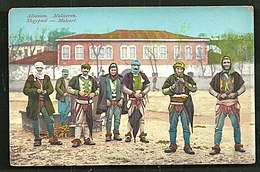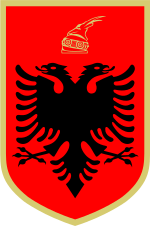Myzeqe
Myzeqe or Myzeqeja (also Musachia) is a plain in the southwestern-central Albania,[1] sometimes referred to as being between the Shkumbin and Seman rivers,[2] and sometimes extending south to the Vjose river north of Vlorë.[3] Administratively, the region falls mainly within Lushnjë and Fier District. Other terms like Myzeqeja e Vogël (Small Myzeqe), Myzeqeja e Beratit (Berat's Myzeqe), or Myzeqeja e Vlorës (Vlora's Myzeqe) are used to point respectively to the Fier part of the region, and to tiny parts that fall into the adjacent districts of Berat and Vlorë.[4] It stretches 65 km north-south and 50 km east-west, with a total area of around 1350 square kilometers.[5] The oldest population to inhabit the Myzeqe plain are the Albanian tribe of the Lalë.[6]
Etymology
The name of the region comes from the Medieval times, it is named after the ruling family of Muzaka (1280 – 1600) which possessed the area. The toponym is first recorded as Musachia in 1417.[5]
History
In antiquity, the Greek colony of Apollonia was founded near the coast. The site of Apollonia lay on the territory of the Taulantii, a cluster of Illyrian tribes that remained closely involved with the settlement for centuries and lived alongside the Greek colonists.[7] The Taulantii controlled much of the plain of Myzeqe in classical antiquity.
In the Middle Ages, and was ruled by various Albanian noble families including the Skuraj and Muzaka families. At various times it was included in the Byzantine Empire and the Bulgarian Empire, often with the local ruling families serving as vassals to the rulers of the realm. Plenty of Slavic language toponyms are present in Myzeqe.[8]
In the late 13th century the area came under the rule of the officially Catholic and French-tied Angevin Kingdom of Albania. At first, relations were bad between the kingdom's rulers and the local nobility, and at times the nobility, such Gjin Muzaka, collaborated with the Byzantines against the kingdom. However, over time the local house of Muzaka came to view the Angevin royal family of Albania as their allies and protectors especially as the threat of Serbian expansion increased, and became more loyal to them. They were given titles as the region became influenced by the Western style of feudalism. At the same time, the Angevins allowed the local rulers to keep their Orthodox faith. In 1318, Andrea I Muzaka became the first ever Orthodox Albanian to be the head general of the kingdom's army, and the Muzakas played a role in King Charles' battles against the Serbs. In other conflicts, the Muzakas sided again with Byzantium, with Andrea II Muzaka being honored for his service to the Byzantine cause in 1335. The remnants of Byzantine control over the region collapsed during the 1341-1347 Byzantine civil war, creating an opportunity which was taken by the Serbian ruler Stefan Dushan, at the expense of the Kingdom of Albania.
In the middle of the 14th century, the region was conquered by Stefan Dushan for Serbia, but it did not take long for the Serbian Empire's control over the region to fragment as the local families reasserted control. Four decades later, the Battle of Savra (as one of the plains of Myzeqe was known in the Middle Ages) marked the ascendancy of the Ottoman Empire in the region. In the 15th century, the Muzaka family and other local Albanian lords joined Skanderbeg's League of Lezha to try to contain the growing dominance of the Ottomans, but after a long conflict, Myzeqe as well as wider Albania ended up decisively under Ottoman rule until the early 20th century. Some of the local Albanian rulers as well as some of the population ended up fleeing to foreign countries, but some of the rulers stayed and became integrated into the Ottoman power apparatus.
In the 18th century, Ali Pasha of Tepelene, a descendant of the noble Muzaka family, built a large despotate spanning large swaths of Albania, Macedonia and Greece, and gained de facto independence for a time from the Ottoman power center. However, ultimately, Myzeqe as well as the rest of Southern Albania was once again brought back under Ottoman control.
In the late Ottoman era, Myzeqeja had a high rate of malaria, as was generally true of wetter areas in the wider region during that time.
In the 20th century, the region was included in newly independent Albania. The middle of the century brought massive changes to the region as large numbers of Cham Albanian refugees from Greece were settled in it, and its wetlands were rapidly drained and industrialized under Communism, turning it into the "granary" of Albania.
Population
| Part of a series on | ||||||||||||||
| Albanian tribes | ||||||||||||||
|---|---|---|---|---|---|---|---|---|---|---|---|---|---|---|
 | ||||||||||||||
|
Tribes and regions
|
||||||||||||||
|
Concepts |
||||||||||||||
|
Culture
|
||||||||||||||
The Lalë are a distinct Albanian tribe from the more populous Tosks and Labs. The medieval Muzaka family was related to this tribe as indicated by the name of its progenitor, Lal Muzhaqi.[6] In the Ottoman period, other Albanian tribes moved to the plain of Myzeqe: the Tosks and Labs. Starting from the late 18th century, a small group of Aromanians from the region of Korçë settled in the region as well. In the first half of the 20th century, refugees from Kosovo and the Sandzak also came in the region after it was annexed by Serbia and Montenegro and then included in Yugoslavia.
These waves of settlement mark Myzeqe as the area where all Albanian subgroups: Gheg, Tosk, and Lab populations meet.[3] Aside from the Vlachs established mainly in Divjake town, and some of the Fier villages and some Romani people practically all the inhabitants of Myzeqe are ethnic Albanians. All people from the region as called Myzeqarë ("People from Myzeqe") which is widely used on a geographical point of view.
Myzeqe is notable in its religious makeup as one of the few fairly large regions of Albania where a majority of inhabitants remained Orthodox Christian throughout the Ottoman rule. In the nineteenth century, Fier became a economic and commercial centre of the Myzeqe plain which consisted of small settlements and villages populated by Aromanians, Orthodox Albanians and Muslim Albanians.[9] Around the era of Albanian independence, statistics show that around Fier, roughly 65% of the population was Christian, while in Lushnja the numbers of Christians and Muslims were comparable.[10] During the 20th century, many Muslim-background Cham Albanians were settled in Myzeqe due to the Expulsion of Cham Albanians. Additionally, in Libofshë, some of the residents are Bosniaks who settled in the village in the early 1920s and have become linguistically assimilated.
Economy
This region is prominent for its agricultural potential, which was not always utilized. Most of today's fields were practically swamps and desolate lands until after World War II. This caused seasonal migration of the population.[11][12] After World War II, the communist government launched massive campaigns for draining the area. Following the increase in agricultural potential, the region gained significant importance. Since then, Myzeqe has been called the "Albanian granary".
References
- "John Musachi: Brief Chronicle on the Descendants of our Musachi Dynasty". Archived from the original on 2010-09-10.
- Balcanica. Srpska Akademija Nauka i Umetnosti. 1979. p. 167.
...у ниској јадранској области Мусакији (каже се још Музакија и Музећија) на западу....она лежи између ушћа река Шкумбе и Семени.
- Eno Koco (2010), Vocal Iso(n): The Preservation of Traditions in North East Mediterranean Practice, Acta Studia Albanica, pp. 74–75
- Emil Lafe, Nikoleta Cikuli, Mevlan Kabo (Instituti i Gjuhësisë dhe i Letërsisë, Akademia e Shkencave e RSH) (2002), Fjalor i emrave gjeografikë të Republikës së Shqipërisë [Dictionary of the geographical names of the Republic of Albania], Shtëpia Botuese "Shkenca", pp. 70, 200, 317, ISBN 9992778334CS1 maint: multiple names: authors list (link)
- Robert Elsie (March 19, 2010), Historical Dictionary of Albania, Historical Dictionaries of Europe, Scarecrow Press, pp. 318–319, ISBN 978-0810861886
- Zojzi, Rrok; Dajaka, Abaz; Gjergji, Andromaqi; Qatipi, Hasan (1962). Etnografa Shqiptare. Academy of Sciences of Albania. p. 55.
- Wilkes 1995, p. 98.
- Petar Skok (1934). Dolazak Slovena na Mediteran. Hrvatska s̆tamparija S. Vidović. p. 106.
Čitava plodna Muzakija prepuna je slovenskih toponima
- Koukoudis, Asterios (2003). The Vlachs: Metropolis and Diaspora. Thessaloniki: Zitros Publications. p. 359. ISBN 9789607760869.CS1 maint: ref=harv (link) "Fier developed into the main commercial and economic centre for the surrounding little settlements and villages on the Myzeqe plain, which were inhabited by Arvanitovlachs and, mainly, Christian and Moslem Albanians."
- Siegfried Gruber. "Regional variation in marriage patterns in Albania at the beginning of the 20th century". www-gewi.uni-graz.at. Retrieved 2014-06-11.
- Ali Farazmand (June 29, 2001), Handbook of Comparative and Development Public Administration, Public Administration and Public Policy, 94, CRC Press, p. 804, ISBN 978-0824704360
- Iz istorije Albanaca: zbornik predavanja : priručnik za nastavnike. Zabod za izdavanje udžbenika Socijalističke Republike Srbije. 1969. p. 61.
Познати пољопривредни рејон Музакија због одласка људи у печалбу није био довољно обрађен.
